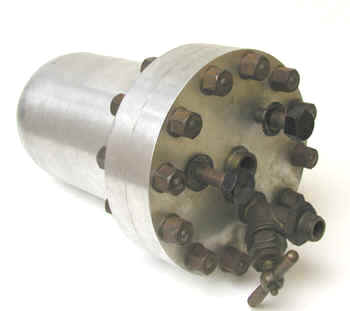High Pressure Ionization Chamber

This high pressure ion chamber was designed and used by Hugh Carmichael in the mid-1930s at the Cavendish Laboratory. It is one of three that were built by Harcourts Limited of Birmingham, England (with the financial assistance of John Cockcroft) to perform cosmic ray measurements in the laboratory and deep underground in the London subway system.
The chamber’s primary purpose was the detection and characterization of cosmic ray ionization bursts, i.e., cascades of electrons generated by muons and photons. To reduce the probability of cascades being produced within the wall itself, the latter was made of Duraluminum, a low Z alloy.
The chamber is approximately 5 inches in diameter and 8 inches long. Its volume is one liter. The fill gas is argon pressurized to 100 atmospheres—the high pressure of the fill gas increased the detector’s sensitivity. An interesting bit of trivia: one of the insulator components was fabricated from a condom.
I fondly recall hand-carrying the thing to the U.S. from Chalk River, Canada and hearing the airport inspector yell "It’s a bomb!" as my suitcase went through the X-ray machine.
Donated by Hugh Carmichael.
Hugh Carmichael was one of the pioneers in the field of cosmic ray studies. His contributions include the first high altitude cosmic ray measurements near the north pole and his characterizations of cosmic ray bursts (cascades). The latter studies were conducted during the mid 1930s while he was working on his doctorate under Ernest Rutherford in the Cavendish laboratory at Cambridge University. Later in the 1960s, he traveled much of North America in a mobile laboratory making what are probably the most extensive series of measurements on cosmic ray intensity as a function of latitude and altitude. He also made numerous contributions in the area of nuclear instrumentation, specifically the development of electrometers, ionization chambers for reactor control and BF3 detectors for the detection of cosmic neutrons.
